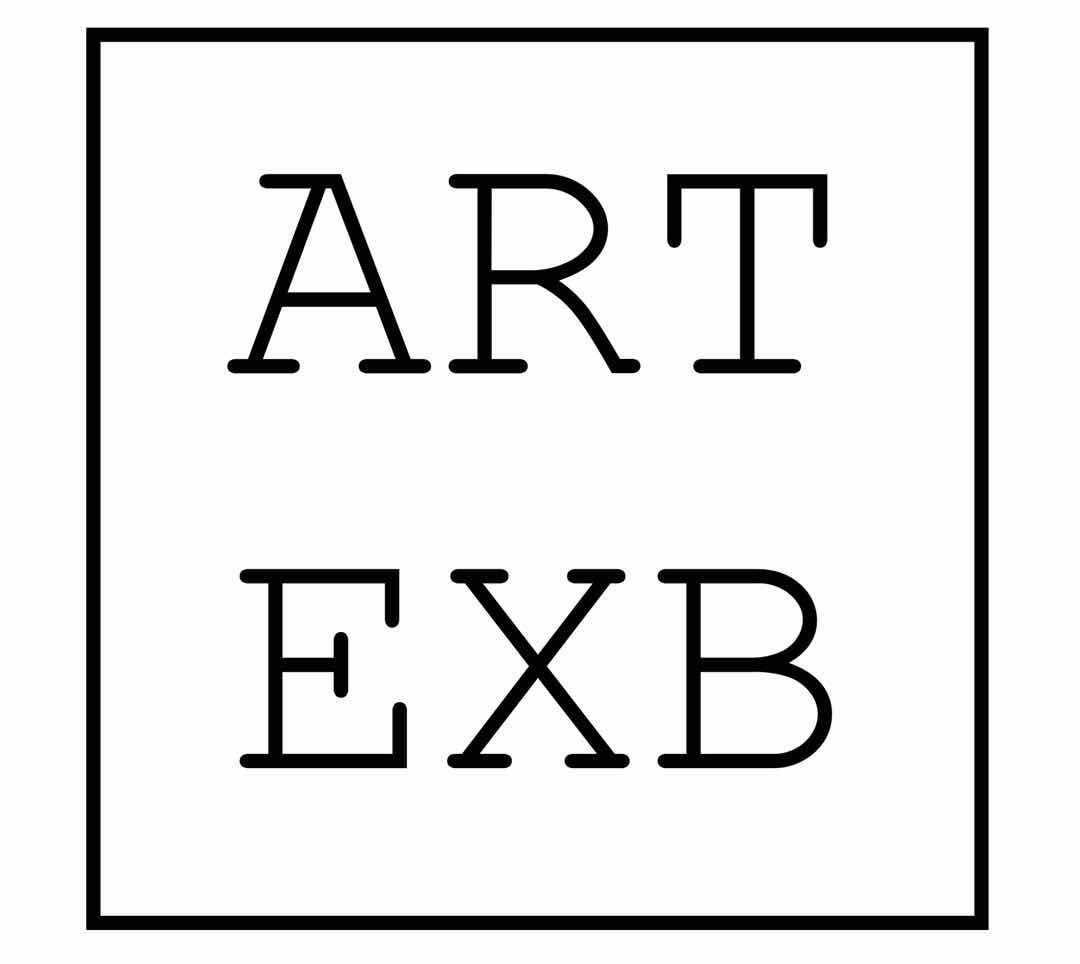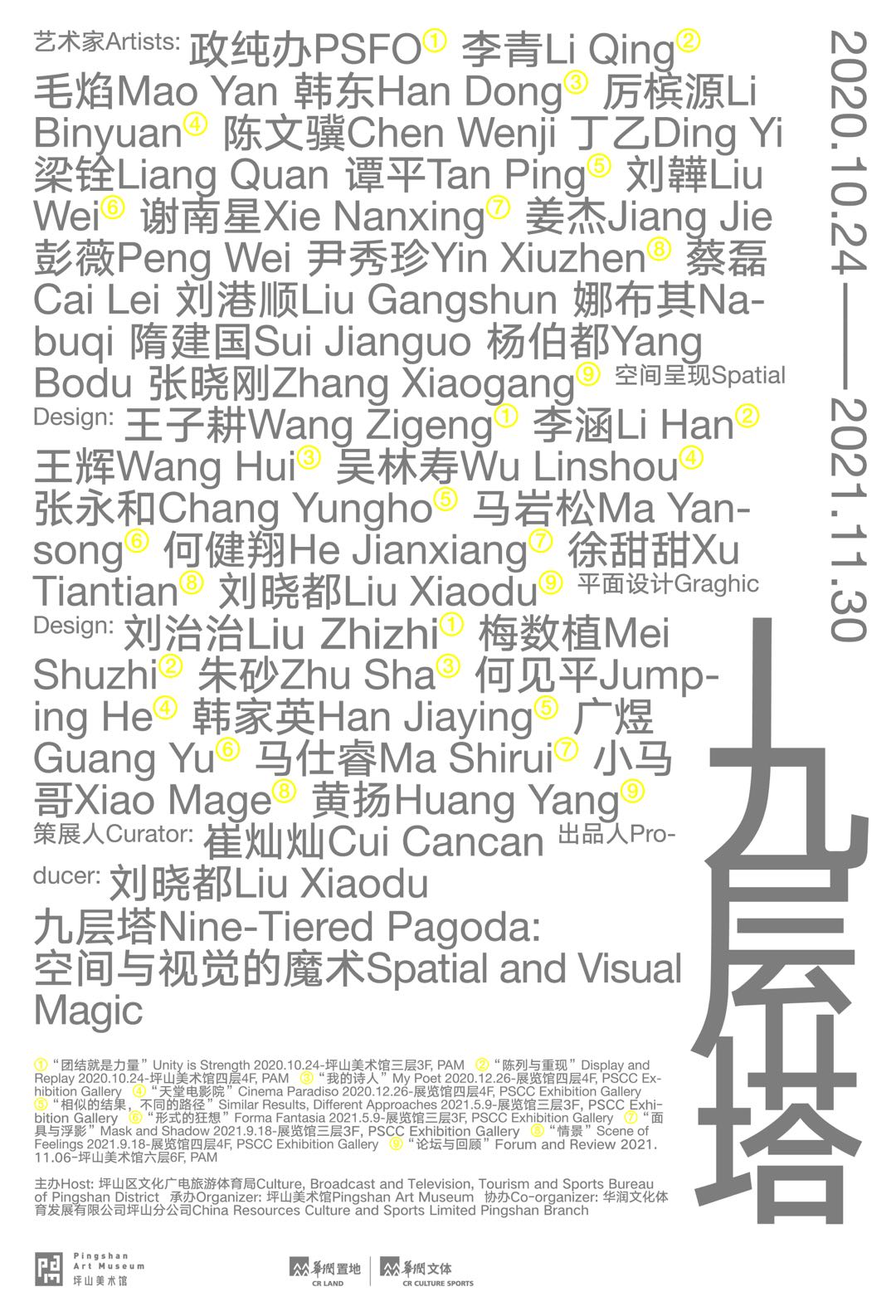“九层塔:空间与视觉的魔术” 是一次跨界行动,是中国从未有过的展览方向和形式。它将邀请9位/组艺术家提供作品,作为展览的基础素材,同时邀请9位建筑师,9位设计师,组成九个临时团队。艺术家、建筑师、设计师三方联名合作,没有 “主次” 和 “中心”,只是分工与协作,最终形成9个全新类型的展览。
空间和设计是决定展览的核心元素,也是对展览和作品的再创作和再生产,它决定了观众看到什么,怎么看,看的次序和节奏。空间和设计,在这里不再是为展览服务,而是独立自主的体验,给予展览无数的变量和可能。
一直以来,我们缺乏一种高质量的跨界,它们不是流俗于明星和网红效应,迎合一种快餐式的出圈,就是自说自话,拘泥于专业壁垒。“九层塔” 倡导的跨界方式,创造了一个艺术、建筑和设计的连接点,一个全新的交叉学科,它既是三个专业间的实际需求,有益协作,又保留了各自的专长和优势,分工得当。
作为中国古代建筑,“塔” 有着一种特殊的结构,它的每一层讲述着不同的故事。这些故事和空间、设计,紧密围绕成一个彼此叠加的整体,成为展览的外在形象和精神内核。
“九层塔:空间与视觉的魔术” 由策展人崔灿灿和建筑师刘晓都共同在2020年发起,它是一个混合了思想、方法、工具的实践项目,也是对跨领域工作的兴趣班,拓展彼此方向的攻关小组。
“九层塔” 的出现,饱含着创造一个全新领域和事业的雄心,旨在发明一种新的合作方式和展览观念,重塑这个时代的感知体验。
“论坛与回顾”
作为九层塔的第九个项目,“论坛与回顾” 是对整场展览的总结和回顾,也是九层塔持续一年后的最后一个项目。
展览分为三个部分,第一部分我们将呈现六位艺术家蔡磊、刘港顺、娜布其、隋建国、杨伯都、张晓刚的作品,从不同的媒介和语系,回应总展览的副标题 “空间与视觉的魔术”。同时,邀请建筑师刘晓都进行空间呈现,平面设计师黄扬进行海报和视觉系统的创作。
第二部分是对整场展览的回溯,九层塔的九场展览将同时呈现。9组非凡的作品,9种 “空间” 和 “设计”,在同一时空中,组成真正意义的 “九层塔”。在此,我们仍要感谢前8层的奉献和付出,他们是艺术家姜杰、彭薇、尹秀珍、谢南星、刘韡、陈文骥、 丁乙 、梁铨 、 谭平、厉槟源、毛焰、韩东、李青、政纯办(洪浩、萧昱、宋冬、刘建华、冷林);建筑师徐甜甜、何健翔、马岩松、张永和、吴林寿、王辉、李涵、王子耕;平面设计师小马哥、马仕睿、广煜、韩家英、何见平、朱砂、梅数植、刘治治。
最后的论坛部分,也是九层塔的塔顶与尾声。我们将在一个既是展厅,又像是剧场、神庙的空间中举行六场论坛。第一场我们将邀请艺术家作为实践者讨论;第二场邀请艺术、建筑和设计类的专业媒体,进行跨界交流;第三场、第四场邀请展览之外的十几位建筑师,第五场我们将邀请展览之外的平面设计师,第六场我们将邀请策展人、艺术机构和评论者。几十位跨领域工作者将在一个月中进行马拉松式的对谈,通过广阔的主题,来拓展我们脑海中的边界。
什么是跨界?为何跨界?为谁跨界?2020年疫情刚刚开始,我和刘晓都提出这些问题。那时,一切坚固的关系,预设的未来,突然被打破,我们陷入了前所未有的空白与混乱。推动这些思考、想法和感知的,不能只是理论的推论,它需要一种全新的姿态、立场、方法,它需要通过漫长的时间,高密度的行动来完成。
“九层塔” 迫使我们进入了一个行动的领域。在这一年里,这些跨越时间、跨越专业和经验的圈层联系,开始摆脱各自因果关系的铁律。他们试图发明新的游戏规则,展示新的功能。当九个空间以真实的方式到来,汇集在一起的时候,它远比任何设想、概念、理论都有力。它是实践的主张,是将跨界的 “思想与方法” 变得可见、可观、可感,是一场长达十六个月的真实变革。
九层塔既是无限的对话,又是广泛的合作,知识的运动,不同领域的人汇集一堂。“空间与视觉的魔术” 并不是为了欣赏和体验的愉悦,白盒子里的魔术,从来不是目的。跨界即摆脱各自的领域,意味着飞翔,飞出传统的展厅,创造出一种全新的、丰富的学科生态,它可以被所有人分享,成为真正意义上的 “公共”,而不是某一学科的殿堂。
我们频繁地联络、组织、沟通、密集快速地实现展览,我们工作的密度,试图和三个领域间的变化保持共震的速度。或者说,我们试图成为变化的一部分,并且成为导致变化的前沿。我们也相信 “重复” 和 “强调” 的力量,在更广阔的公共领域,调动所能调动的所有资源,九个展厅、十几次对谈,每条微信的编辑、推送,到近百家不同领域的媒体,它都是九层塔申明主张的战场。我们希望它能发出更多的声音,被更多不同领域的人看到,哪怕只是激起好奇,也是对过去的松动。
同样,我们建立了一个社群,一个前后近百人的链接群体,有建筑师、艺术家、设计师、机构、媒体、作者共同协作的社群。一年来,九层塔的自我组织、开放实践,广泛运动的机制,从中生长出来的有机项目,在各个领域不断蔓延。九层塔,延伸出来的展览形式、合作方法,为很多机构和项目提供了全新的模式和想象力,有些在未来仍会不断发生。
展览行进的一年中,不断的有人问为什么叫 “九层塔”,“九层塔” 的含义是什么?事实上,最初的 “九层塔” 是一个并无太多含义的词汇,它需要我们不断地通过实践赋予它内涵,一层一层地叠加给予它形状和样子。直至人们再提起它时,它代表和象征着我们曾经给出的意义。
我们所实践的,不仅仅是此刻的想象,同时也是我们这个世纪对开放的渴望。
策展人 崔灿灿
“Forum & Review”
Nine-Tiered Pagoda: Spatial and Visual Magic, as a cross-disciplinary event, represents an unprecedented direction and form of exhibition in China. Nine (groups of) artists will provide their works as the basis material for the exhibition. Besides, nine architects and nine designers will also join to form nine temporary teams, hence the cooperation among artists, architects and designers. There is no ‘priority’ or ‘center’ in the exhibition, only division of labor and collaboration, presenting nine individual exhibitions of a brand-new type.
As the core determinant for the exhibition, space and design are also a kind of re-creation of the exhibition and the work; They determine the content and how the audience see the exhibition, as well as the sequence and pace. Space and design, no longer in the service of the exhibition, provide an independent and autonomous experience for the audience, granting the exhibition a myriad of variables and possibilities.
There has always been a lack of quality cross-disciplinary exhibitions, which are neither a fast food product preached by celebrities and online influencers nor a highbrow art confined to professional barriers. The cross-disciplinary advocated by Nine-Tiered Pagoda creates a nexus joining art, architecture and design together with a new cross-discipline, which reflects the practical needs and collaboration of the three professions, while it also retains the expertise and strengths of each with a proper division of labor.
As an ancient Chinese architecture, ‘Pagoda’ has a special structure, with each tier telling a different story. These stories, spaces, and designs are closely intertwined with each other into a superimposed whole, formulating the external image and spiritual core of the exhibition.
Nine-Tiered Pagoda: Spatial and Visual Magic, launched by curator Cui Cancan and architect Liu Xiaodu in 2020, is a hands-on project that mixes ideas, methodologies and tools. It’s not only a workshop for cross-disciplinary art, but also a platform for artists, architects and designers to cooperate and expand their development realms together.
The advent of Nine-Tiered Pagoda represents the ambition to create an entirely new field, with an aim to invent a new way of collaboration and to create a fresh exhibition concept that can reshape the perceptual experience of our times.
As the ninth and also the last project of Nine-Tiered Pagoda, “Forum & Review” brings the conclusion and retrospection for the whole exhibition over the past year.
The exhibition is divided into three parts. Starting from works created by six artists, namely Cai Lei, Liu Gangshun, Nabuqi, Sui Jianguo, Yang Bodu, Zhang Xiaogang, Part One, with architect Liu Xiaodu creating the space, and graphic designer Huang Yang in charge of posters and other visual designs, echoes the subtitle of the exhibition, “Spatial and Visual Magic”, via different media and discourse systems.
Part Two is the recall of the whole exhibition with all nine “tiers” being presented simultaneously. The nine sets of extraordinary works with nine kinds of “space” and “design” constitute, and are also converged into, a real “Nine-Tiered Pagoda”. Our sincere appreciation goes to all participants for their endeavor in the first eight solo exhibitions. They are: Artist Jiang Jie, Peng Wei, Yin Xiuzhen, Xie Nanxing, Liu Wei, Chen Wenji, Ding Yi, Liang Quan, Tan Ping, Li Binyuan, Mao Yan, Han Dong, Li Qing, PSFO (Hong Hao, Xiao Yu, Song Dong, Liu Jianhua, Leng Lin); Architect Xu Tiantian, He Jianxiang, Ma Yansong, Chang Yongho, Wu Linshou, Wang Hui, Li Han, Wang Zigeng; Graphic designer Xiao Mage, Ma Shirui, Guang Yu, Han Jiaying, Jumping He, Zhu Sha, Mei Shuzhi, Liu Zhizhi.
At the top tier of the Pagoda, also the last part of the exhibition, we’ll hold six forums in a space resembling an exhibition hall, a conference room, a theater or even a temple. In the first forum, we will have artists carrying out discussions as practitioners; In the second one, we will invite professional media from art, architecture, design for more transboundary exchanges; Dozens of architects outside this exhibition will attend the third and fourth forum; In the fifth one, we will meet more graphic designers while exhibition curator, art institutions and critics will gather in the last forum. All participants from different disciplines will have marathon-like dialogue in the two months, aiming to expand the boundary in our mind via extensive topics.
What is cross-disciplinary? Why do we need it? For whom do we practice it? These are the questions brought up by Liu Xiaodu and me during the pandemic outbreak back in 2020 when all the seemingly solid relationship and presupposed future suddenly collapsed as we were all falling into an unprecedented blank and chaos. Mere theoretical deduction can hardly promote our thinking, thoughts and perceptions. Instead, a brand-new posture, stance, and method is needed for the process, hence the requirement for longer time invested and highly intensive practices.
“Nine-Tiered Pagoda” forces us to take actions. During the past year, those outreaching relations transcending time, disciplines and experience have begun to eliminate the eternal law of cause and effect, with an attempt to create new game rules and present new functions. When nine spaces actually converge in reality, their integration appears to be stronger than any vision, concept, or theory. It is a practical proposition, making the “idea and method” of cross-disciplinary encounter visible and perceivable in the sixteen months of real revolution.
Nine-Tiered Pagoda represents an infinite dialogue, an extensive cooperation, as well as a knowledge campaign where people from all walks of life get together. “Spatial and Visual Magic” is not for the pleasure of appreciation or experience. Magic in the white box is never our purpose. Cross- disciplinary means getting rid of the fixed disciplinary setting and flying out of conventional exhibition halls, thus creating a new and abundant ecosystem which can be shared by all people and become “communal” in a real sense, rather than serving as the palace for any specific subject.
We have frequently contacted, organized and communicated with each other to intensively and rapidly realize the exhibitions. We’ve tried to work at the same pace with the changes in three fields, or to become part of the changes and even lead these changes. And we believe in the strength of “repetition” and “emphasis”. We’ve mobilized all resources we can in a broader common field, with all nine exhibition halls, dozens of dialogues, all the texting and notification on WeChat as well as nearly one hundred media in different fields being our battlefield to demonstrate the proposition of Nine-Tiered Pagoda. We hope the Pagoda can be heard and seen by more people from other fields as any slight ripple of curiosity stirred thereby will bring a wave vibrating the fixed paradigm formed in the past.
Meanwhile, we’ve built a community bringing together nearly 100 people including architects, artists, designers, institutions, media and authors. Myriads of organic programs sprouted out of the mechanism of Nine-Tiered Pagoda featuring self-organization, universal practice and broad movement are now thriving in many fields. Exhibition forms and new ways of cooperation extending thereof have provided brand-new patterns and inspirations to other institutions and programs which will continue to take place in the future.
People keep asking me the significance behind Nine-Tiered Pagoda during the past year. In fact, the name itself did not contain any meanings from the very beginning. It is us who are giving it different connotations via our artistic practices, adding more details to it tier by tier. And the Pagoda will stay the way we shaped it whenever people bring it up again.
What we practice is not only imagination at the current moment, but also the desire to the openness in this era.
Cui Cancan, Curator

